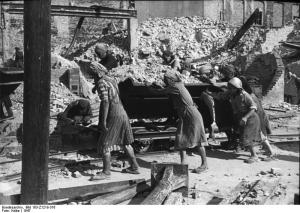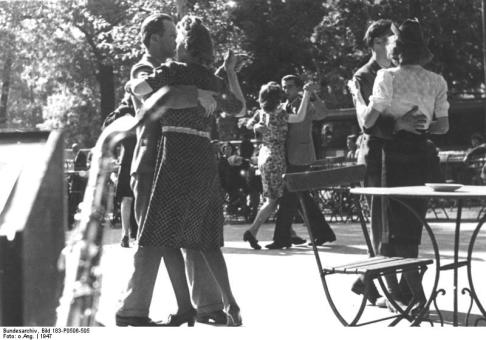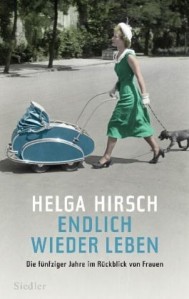There’s a fascinating argument going on in Germany right now. It digs at one of modern Germany’s founding myths.
In one corner is the historian Leonie Treber of the University of Duisburg-Essen, so my neck of the woods. Her dissertation just appeared as a book called The Myth of the Rubble Women (Mythos Trümmerfrauen).
In the other corner is, well, most people who actually lived in the immediate postwar years and care to comment in the media about Treber’s book.
As I wrote in a post last year on postwar Germany’s iconic women, the Trümmerfrau  is the heroine of the country’s rise from the ruins. Treber argues this is a legend that evolved in the Sixties and Seventies in West Germany (earlier in East Germany).
is the heroine of the country’s rise from the ruins. Treber argues this is a legend that evolved in the Sixties and Seventies in West Germany (earlier in East Germany).
She analyzed government documents related to reconstruction in 11 German cities and concluded the women generally didn’t stack bricks or push rubble on carts. Most of the work was done by removal and construction companies. In the immediate postwar years, she says, there was no term “Trümmerfrau,” and only in Berlin and cities in the Soviet Zone did women do significant amounts of work in the ruins.
When I first heard about this, I thought, “Uh-oh.” Treber is tarnishing one of the beloved images of post-Nazi Germany.
Modern West Germany needed to reinvent its history, create its own founding myths. Every country does it. The “rise from the ashes” story needed its heroes at a time when there were very few to go around. Postwar Germany in the late Forties and into the Fifties was in many areas still clearly in the hands of ex-Nazis. The men wouldn’t be the image of the new Germany. The women who got on with it while the men were imprisoned, broken or dead — they kept society together.
And that’s where myth and memory clash with data. My local paper the NRZ published excerpts of some of the mostly infuriated letters-to-the-editor that arrived after the paper reported on Treber’s book.”The suffering of these women isn’t even appreciated,” one said. Another didn’t hold back: “What is this silly goose thinking when she defames the proven achievements of the Trümmerfrauen?”
Some letters insisted they used the term Trümmerfrau as early as the Fifties here in western Germany. They pointed out that not only did their mothers carry bricks, so did the children (and some men, of course). It wasn’t a matter of rebuilding whole city blocks, it was about the family home, the shop, the school. People rebuilt their own neighborhoods brick by brick. The private stories have poured in, and if you know German, you can read some on the WAZ (NRZ) newspaper group site here.
Treber’s book has gotten some attention for its controversy, and it’s fun to watch. My opinion? A good story is sometimes “truer” than the facts. It isn’t important to measure the achievements of these women in cubic meters of rubble. Postwar German women were the first to pick up the pieces — because they had to. For that, they deserve a place in Germany’s founding story.
Photo:Bundesarchiv, Bild 183-Z1218-316 / Kolbe / CC-BY-SA [CC BY-SA 3.0 de (http://creativecommons.org/licenses/by-sa/3.0/de/deed.en)%5D, via Wikimedia Commons http://upload.wikimedia.org/wikipedia/commons/b/b1/Bundesarchiv_Bild_183-Z1218-316%2C_Tr%C3%BCmmerfrauen_bei_der_Arbeit.jpg




